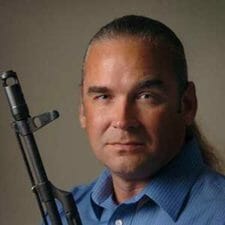
commons.wikimedia.org/w/index.php?curid=50323029
USA – -(AmmoLand.com)- Richard Collins owns more than 1,000 machine guns and 4,000 other firearms. He stores his massive collection in two safes. Each is 1,000 square feet – the doors weigh 5,000 pounds.
Collins is president of Movie Armaments Group. Founded 40 years ago, MAG supplies guns, tactical gear, uniforms, military equipment, and lashings of expertise to the film industry. All of his armorers are veterans of elite police and/or military units.
Some of the films he’s worked on include: “Suicide Squad,” “Total Recall,” “Robocop,” and “xXx,” with Vin Diesel.
Collins’ team does much more than supply guns.
“If a stunt guy knocks a gun out of someone’s hand, we made the gun out of latex. It has the consistency of a soft rubber sponge, not hard rubber,” he said Tuesday. “We build soft-rubber fire extinguishers, pipes if someone is going to be hit with a pipe. We have five fulltime artists and 3D printers. We make molds and build stuff too.”
His business is booming, especially after Netflix and Amazon began producing their own movies.
“We’re based in Toronto, which they call ‘Hollywood North.’ We have major studios here, and the Canadian dollar is cheaper – 25% cheaper than Hollywood. You’ll get a bigger bang for your buck,” he said. “Hollywood directors and producers come up here and are shocked at how much depth of film-production talent is here. We can do everything Hollywood can do, except for less money.”
Few people know more about gun safety protocols on a movie set than Collins, who’s been in the film industry for more than 40 years. An experienced armorer himself, Collins was troubled by the news stories he read about the recent shooting death on the set of Alec Baldwin’s low-budget film, “Rust,” which left cinematographer Halyna Hutchins dead and director Joel Souza wounded.
“The information I’m getting is third-hand, mostly stories I’ve read in the press,” he said. “They don’t seem to understand what they’re reporting and they’re screwing it up. You have to be wary about whether what they’re saying actually happened.”
Collins reached out to the Second Amendment Foundation’s Investigative Journalism Project to set the record straight.
“Everything that was done there is against protocols,” Collins said. “There is no law that governs what armorers do on set, but there are safety protocols set by the film union.”
Anyone working with firearms onset is required to read the safety rules, Collins explained, and the producers and directors have to be aware of the rules.
“The number one rule is no live ammunition can come to the set – period,” he said. “The second rule is that firearms used for live fire are never brought to the set. We have firearms dedicated to blank fire.”
Ultimately, the armorer is responsible for safety when firearms are used, which on the “Rust” set was the responsibility of 24-year-old Hannah Gutierrez Reed.
“In this case the armorer was a young girl and she didn’t know how to put her foot down,” Collins said. “No one should touch guns but the armorer.”
Armorers are required to keep all firearms in their “custody and control” at all times. Crew members or others not working with the guns are not allowed to touch them. If the armorer needs to go to the bathroom or take a break, they’re supposed to contact another armorer to relieve them. In this case, Collins said, since it was a low-budget film, Reed was the only armorer on set, so she should have asked someone from the props department to look after the guns so no one handled them if she needed a break.
Alec Baldwin’s fatal shooting occurred during a “cold gun” scene involving a real firearm, which has its own safety protocols.
Reed should have cleared the revolver herself to ensure it was not loaded. Then, she should have cleared or “proofed” the weapon for the assistant director. Then, she should have proofed the weapon for the “talent,” in this case Baldwin. After acknowledging the gun was clear, only then should Baldwin have accepted the gun from her.
“None of that was done with Baldwin,” Collins said. “He’s been on gun movies before. He knows the procedures. You don’t accept the gun from the assistant director, which was done here. You accept the gun only from the armorer.”
Clearing a single-action revolver like the one Baldwin used is a tedious process.
“You open the gate. The gun is on half-cock. You check each chamber – you check seven chambers to make sure you didn’t miss one. Then, you bring back the hammer and drop the hammer seven times, and then you do the same for the actor before you hand it to them,” Collins said. “The talent has got to see that. They’ve got to know you’re safe. Lots of talent are afraid of firearms. You have to hold their hand a bit and keep them safe. You have to overdo it. When an armorer does everything they’re supposed to, the gun’s empty. Everyone’s checked it. We all know it’s safe. There’s no problem. We can relax. Everyone’s always in a hurry on set. They’re always behind schedule. They will try to rush you. You can’t allow that.”
During the “Rust” production, the armorer Reed was not allowed on set because of COVID-19 regulations.
“That’s bullshit if that’s true,” Collins said. “She screwed up and didn’t hand the gun to the talent because she wasn’t allowed to be there. There’s a cardinal rule: The armorer is responsible to clear the gun, clear it again, go to the talent and clear it again. That rule is never broken.”
Collins just learned that someone may have used the revolver for after-hours plinking offset, which is never allowed.
“Nobody ever does that. There’s no live ammo allowed on set. Someone was shooting live rounds, didn’t clear it and brought it back to the set. This is insane. No one is allowed to take a gun that’s been shooting live ammo and bring it back to the set,” Collins said. “These are ironclad rules. Every armorer I’ve spoken to is in shock. What were they thinking? What were they doing?”
Dummy Rounds
When the camera focuses tightly on a revolver, you can see the cylinder is empty, so armorers will use dummy rounds that look like real bullets, Collins explained.
Hollywood dummy rounds each contain a small ball bearing, and they have their own safety protocol.
“If a firearm is supposed to be loaded with dummy rounds, my armorers are trained to take each round and shake it to hear the ball bearing rattle. They will go through every round and demonstrate to the talent that they can’t be real because real rounds don’t rattle,” Collins said. “These rounds have been around for a few years and they’re a fantastic solution.”
As a result, if the safety protocol was followed, there is no way a live round could be mistaken for a dummy round.
No Training
Depending upon a film’s budget, Collins’ firm may be hired to provide firearm training to the actors.
“We will do safety training with them first, and get them used to the guns. It’s very hard to act like a professional killer if you’re afraid of the gun, so we train them. We have curriculum, depending upon how much they need to know. In this case, the big problem is that the movie was extremely low budget, so they didn’t want to pay for training or even a second armorer.” Collins said. “I heard one of the other major armorers said he was asked to take the contract but he said no. Because of the extremely low budget he refused to accept the job. They were not following the protocols.”
Blame
On the “Rust” set, there is a lot of blame to go around.
“As far as the blame goes, the armorer is the number one person to blame,” Collins said.
“Baldwin would have known you don’t take a gun without it being cleared by an armorer. He’s responsible as a producer.
Producers know no one accepts a gun without the armorer proofing it first. I can’t believe this happened. Who would do this? Protocols are not complicated. You’re supposed to follow them and never break them.”
Like after any shooting, Collins suspects anti-gunners will use this death as an opportunity to call for more gun bans.
“They want to ban real firearms from film sets and replace them with Airsoft,” he said. “They want to put me out of business.”
This story is presented by the Second Amendment Foundation’s Investigative Journalism Project and wouldn’t be possible without you. Please click here to make a tax-deductible donation to support more pro-gun stories like this.
About Lee Williams
Lee Williams, who is also known as “The Gun Writer,” is the chief editor of the Second Amendment Foundation’s Investigative Journalism Project. Until recently, he was also an editor for a daily newspaper in Florida. Before becoming an editor, Lee was an investigative reporter at newspapers in three states and a U.S. Territory. Before becoming a journalist, he worked as a police officer. Before becoming a cop, Lee served in the Army. He’s earned more than a dozen national journalism awards as a reporter, and three medals of valor as a cop. Lee is an avid tactical shooter.

